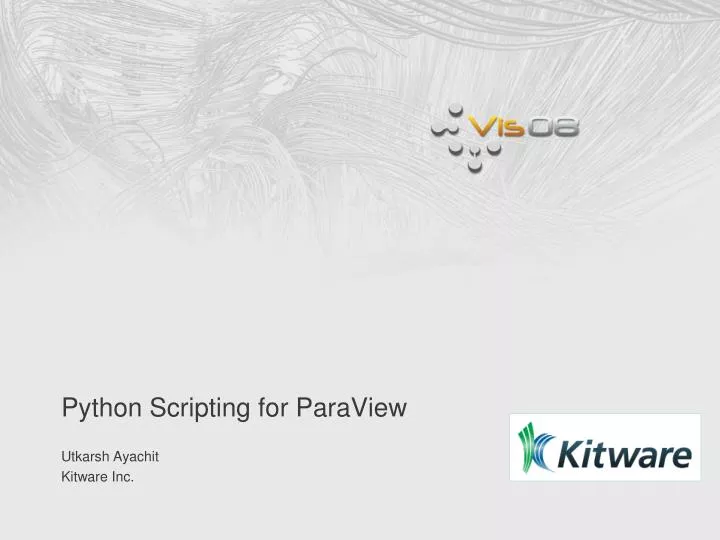

| Initialize = aInitialize(self, connection=None) | The Cone source can be used to add a polygonal cone to the 3D scene. Help on Cone in module rvermanager object: You can get some documentation about the cone object using help(). You can get a list of objects this module can create from ParaView's online help (from help menu or here: ) The simple module contains many functions to instantiate sources, filters, and other related objects. Tab completion works just as in any other shell. In summary, you need to create a variable PYTHONSTARTUP as (in bash): To use auto-completion in pvpython, one can use the tips provided at. One can also use IDLE, for example to enable auto-completion. The Python shell in the ParaView Qt client provides auto-completion. Connecting to a ParaView server running on a cluster is covered later in this document. In this example, we will use ParaView in the stand-alone mode. This document refers to the simple module alone. Note: Importing the paraview module directly is deprecated, although still possible for backwards compatibility.
#Paraview python tutorial mac#
When using a Mac to use the build tree in IDLE, start by loading the servermanager module: (Under WindowsXP for a debug build of paraview, set both PATH and PYTHONPATH environment variables to include $/lib/site-packages to make it work.) Users/berk/work/paraview3-build/lib (/Users/berk/work/paraview3-build/bin for versions before 3.98) The corresponding LD_LIBRARY_PATH would be:
#Paraview python tutorial windows#
PATH on Windows and LD_LIBRARY_PATH on Unix/Linux/Mac). You may also need to set your path variable for searching for shared libraries (i.e. Users/berk/work/paraview3-build/bin:/Users/berk/work/paraview3-build/Utilities/VTKPythonWrapping - Andy.bauer 23 July 2010. Note: For older versions of ParaView this was /Users/berk/work/paraview3-build/bin:/Users/berk/work/paraview3-build/Utilities/VTKPythonWrapping/site-packages - Andy.bauer 24 January 2013, or Users/berk/work/paraview3-build/lib/ Release:/Users/berk/work/paraview3-build/lib/site-packages In those cases add the correct folder where the *.libs reside: Note that depending on your build configuration, your *.libs files may not be under "lib" but under one of its sub-folders, like "lib/Release" or "lib/Debug". Users/berk/work/paraview3-build/lib:/Users/berk/work/paraview3-build/lib/site-packages This tutorial will be using the python integrated development environment IDLE. You do not have to set PYTHONPATH when using these.

You can also use either pvpython (for stand-alone or client/server execution), pvbatch (for non-interactive, distributed batch processing) or the python shell invoked from Tools|Python Shell using the ParaView client to execute Python scripts. These files are the shared libraries located in the paraview binary directory and python modules in the paraview directory: paraview/simple.py, paraview/vtk.py etc. This module can be loaded from any python interpreter as long as the necessary files are in PYTHONPATH. To start interacting with the Server Manager, you have to load the "simple" module. You may also visit the Python recipes page for some examples. This document is a short introduction to ParaView's Python interface. Note: Server Manager is a library that is designed to make it easy to build distributed client-server applications. Using Python, users and developers can gain access to the ParaView engine called Server Manager.

This support is available as part of the ParaView client (paraview), an MPI-enabled batch application (pvbatch), the ParaView python client (pvpython), or any other Python-enabled application. ParaView offers rich scripting support through Python. 5.6 Writing Data Files (ParaView 3.9 or later).


 0 kommentar(er)
0 kommentar(er)
